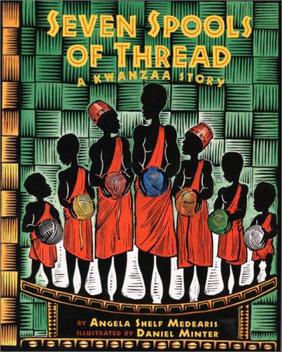Seven Spools of Thread facts for kids
 |
|
| Author | Angela Shelf Medearis |
|---|---|
| Language | English |
| Genre | Picture book |
| Published | 2000 |
| Publisher | Albert Whitman Company |
| ISBN | 9780807573150 |
Seven Spools of Thread: A Kwanzaa Story is a picture book published in 2000. It was written by Angela Shelf Medearis and illustrated by Daniel Minter. The book tells the story of seven Ashanti brothers. They must learn to work together. The story also shows the seven important principles of Kwanzaa.
Contents
The Story of Seven Spools of Thread
Seven Spools of Thread is about seven Ashanti brothers. They live in a village in West Africa. These brothers are always fighting and arguing. They never agree on anything.
Brothers Who Learn to Work Together
One day, their father dies. He leaves them a strange task. They must make gold from seven different spools of silk thread. Each spool is a different color. They have until sundown to finish. If they fail, they will lose their home. This challenge forces the brothers to finally work together.
Weaving a New Future
The brothers realize they need to combine their efforts. They learn to weave the different colored threads together. They create beautiful, multi-colored cloth. They sell this cloth for gold. Later, they teach others in their village how to weave. This helps the whole town become richer. The author, Angela Shelf Medearis, imagined this story as a way to explain how Kente cloth might have been created.
Kwanzaa and Its Principles
The book subtly teaches the seven principles of Kwanzaa. Kwanzaa is a celebration of African culture and heritage. It is observed by many people around the world.
What is Kwanzaa?
Kwanzaa is a holiday celebrated from December 26 to January 1. It honors African heritage and culture. Each day focuses on one of seven core principles. These principles are about community, family, and self-improvement.
The Seven Principles in the Story
Angela Shelf Medearis explains more about Kwanzaa in her author's note. The story of the brothers shows how these principles can guide people. For example, the brothers learn Ujima (Collective Work and Responsibility). This means working together to build and maintain their community. They also learn Ujamaa (Cooperative Economics). This principle is about building and maintaining their own businesses. They work together to profit as a group.
Art and Culture in the Book
The book also shares interesting facts about West African culture. It includes details about traditional cloth weaving.
The Art Style
The illustrations in Seven Spools of Thread are very unique. They were made using a method called linoleum-block printing. This technique gives the pictures a bright and bold look.
Learning About West African Weaving
At the end of the book, Medearis provides more information. She describes how cloth is traditionally woven in West Africa. She even includes instructions for readers to make their own belt. This helps children learn more about the culture shown in the story.

